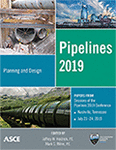Pipelines 2019
Axial Connection Force Capacity Required for Buried Pipelines Subjected to Seismic Permanent Ground Displacement
Publication: Pipelines 2019: Planning and Design
ABSTRACT
Buried pipelines are susceptible to damage from ground movements triggered by earthquakes, such as liquefaction-induced lateral spreading, landslides, and fault rupture. Given the linear characteristics of water and wastewater pipelines, failure due to ground displacement is most likely to occur at locations of weakness, which for segmented pipelines is typical at joints or fittings linking adjacent sections of pipe. Connections can be characterized as unrestrained (e.g., bell-and-spigot joints), fully restrained (e.g., continuous systems with welded/fused connections), or hybrid segmented joints, which provide the ability to displace axially in response to ground movement before locking up and behaving as a continuous system. The joint type and geometry will contribute significantly to the expected performance of a given pipe system subjected to axial and/or transverse ground movements. Furthermore, the connection force capacity of the joints is an important limit state for predicting failure of pipe systems for which the joint has less strength than the pipe barrel. To support the development of an ASCE/UESI manual of practice (MOP) on Seismic Design of Water and Wastewater Pipelines, this paper presents a framework for establishing the minimum connection force capacity (based on burial conditions and pipe/connection characteristics) required for a particular system to be classified in one of four proposed seismic demand categories defined by the MOP. To predict system response to various levels of ground movement, an analytical model is paired with a statistical approach to compare the survival rate of pipe systems that have performed well in past earthquakes to the expected survival of other systems composed of different materials and mechanical connections. Results will aid seismic capacity classification by providing a basis for establishing connection force capacity coefficients for new and existing systems.
Get full access to this article
View all available purchase options and get full access to this chapter.
ACKNOWLEDGEMENTS
The authors gratefully acknowledge the contributions of the ASCE/UESI Task Committee on Seismic Design of Buried Water/Wastewater Pipelines through constructive discussion. They also recognize the excellent contributions of undergraduate researcher Lauren Strand to this study.
REFERENCES
American Society of Civil Engineers. (1984). Guidelines for the Seismic Design of Oil and Gas Pipeline Systems. New York: ASCE.
Bartlett, S.F., & Youd, T.L. (1992). Empirical analysis of horizontal ground displacement generated by liquefaction-induced lateral spreads. National Center for Earthquake Engineering Research, Technical Report NCEER-92-0021.
Bouziou, D., & O’Rourke, T.D. (2017). <Response of the Christchurch water distribution system to the 22 February 2011 earthquake>. Soil Dynamics and Earthquake Engineering, 97 (December 2016), 14–24. https://doi.org/10.1016/j.soildyn.2017.01.035
Davis, C.A., Rajah, S., Wham, B.P., & Heubach, W.F. (2019). <Strain Demands on Buried Pipelines from Earthquake-Induced Ground Movements>. Proceedings: Pipelines 2019. Nashville: American Society of Civil Engineers (ASCE). (accepted).
Davis, C.A., & Wham, B.P. (2019). <Buried Hybrid-Segmented Pipes Subjected to Longitudinal Permanent Ground Deformation>. Proceedings: 8th International Symposium on Earthquake Engineering for Lifelines and Critical Infrastructure Systems. Shenyang, China.
International Organization for Standardization (ISO). (2006). International Standard ISO 16134:2006 Earthquake- and subsidence-resistant design of ductile iron pipelines. First edition. Switzerland: ICS: 23.040.10, TC/SC: ISO/TC 5/SC 2.
Japan Ductile Iron Pipe Association. (2001). <Japan Ductile Iron Pipe Association: Q&A>. Retrieved November 30, 2018, from https://www.jdpa.gr.jp/q_sekkei.htm
O’Rourke, M.J., & Liu, X. (2012). Seismic Design of Buried and Offshore Pipelines. Buffalo, NY: Multidisciplinary Center for Earthquake Engineering, MCEER-12-MN04.
O’Rourke, M.J., & Nordberg, C. (1992). Longitudinal Permanent Ground Deformation Effects on Buried Continuous Pipelines. National Center for Earthquake Engineering Research, NCEER-92-0014.
O’Rourke, T.D., Jeon, S.S., Toprak, S., Cubrinovski, M., Hughes, M., Van Ballegooy, S., & Bouziou, D. (2014). <Earthquake response of underground pipeline networks in Christchurch, NZ>. Earthquake Spectra, 30(1), 183–204. https://doi.org/10.1193/030413EQS062M
Wham, B.P., Argyrou, C., O’Rourke, T.D., Stewart, H.E., & Bond, T.K. (2015). <PVCO pipeline performance under large ground deformation>. Proceedings: ASME 2015 International Pipeline Geotechnical Conference, IPG 2015 (Vol. 139, pp. 1–10). Bogota, Columbia: ASME. https://doi.org/10.1115/IPG2015-8508
Wham, B.P., Argyrou, C., O’Rourke, T.D., Stewart, H.E., & Bond, T.K. (2016). <PVCO Pipeline Performance Under Large Ground Deformation>. Journal of Pressure Vessel Technology, 139(1), 011702. https://doi.org/10.1115/1.4033939
Wham, B.P., Berger, B.A., & Davis, C.A. (2019). <Characterization of soil-structure interaction for seismic design of hazard-resistant pipeline systems>. Proceedings: 7th International Conference on Earthquake Geotechnical Engineering. Roma, Italy. in press.
Wham, B.P., Berger, B.A., O’Rourke, T.D., Pariya-Ekkasut, C., & Stewart, H.E. (2017a). Performance Evaluation of Bionax SR PVCO Pipeline with Extended Bell Joints under Earthquake-Induced Ground Deformation. Ithaca, NY: Cornell University.
Wham, B.P., Berger, B.A., Pariya-Ekkasut, C., & O’Rourke, T.D. (2018a). <Hazard-resilient Pipeline Joint Soil-structure Interaction under Large Axial Displacement>. Proceedings: Geotechnical Earthquake Engineering and Soil Dynamics V (Vol. 2018–June, pp. 276–285). Austin, TX: American Society of Civil Engineers. https://doi.org/10.1061/9780784481486.029
Wham, B.P., Berger, B.A., Pariya-Ekkasut, C., O’Rourke, T.D., Stewart, H.E., Bond, T.K., & Argyrou, C. (2018b). <Achieving Resilient Water Networks – Experimental Performance Evaluation>. Proceedings: Eleventh U.S. National Conference on Earthquake Engineering(p. 11). Los Angeles, CA.
Wham, B.P., Dashti, S., Franke, K., Kayen, R., & Oettle, N.K. (2017b). <Water supply damage caused by the 2016 Kumamoto Earthquake>. Lowland Technology International, 19(3), 151–160.
Wham, B.P., & Davis, C.A. (2019). <Buried Continuous and Segmented Pipes Subjected to Longitudinal Permanent Ground Deformation>. Journal of Pipeline Systems - Engineering and Practice, (in press).
Wham, B.P., Pariya-Ekkasut, C., Argyrou, C., Lederman, A., O’Rourke, T.D., & Stewart, H.E. (2017c). <Experimental Characterization of Hazard-Resilient Ductile Iron Pipe Soil/Structure Interaction under Axial Displacement>. Proceedings: Congress on Technical Advancement (pp. 124–134). Duluth, MN: American Society of Civil Engineers. https://doi.org/10.1061/9780784481028.013
Information & Authors
Information
Published In
Pipelines 2019: Planning and Design
Pages: 299 - 308
Editors: Jeffrey W. Heidrick, Burns & McDonnell and Mark S. Mihm, HDR
ISBN (Online): 978-0-7844-8248-3
Copyright
© 2019 American Society of Civil Engineers.
History
Published online: Jul 18, 2019
Published in print: Jul 18, 2019
Authors
Metrics & Citations
Metrics
Citations
Download citation
If you have the appropriate software installed, you can download article citation data to the citation manager of your choice. Simply select your manager software from the list below and click Download.
